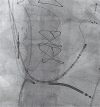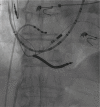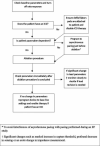The Effects of Catheter Ablation on Permanent Pacemakers and Implantable Cardiac Defibrillators
- PMID: 32477770
- PMCID: PMC7252655
- DOI: 10.19102/icrm.2017.080303
The Effects of Catheter Ablation on Permanent Pacemakers and Implantable Cardiac Defibrillators
Abstract
Catheter ablation is a procedure that is frequently performed in patients with cardiac implantable electronic devices. Here, we review all of the potential interactions that can occur among patients undergoing catheter ablation while having implantable cardiac electronic devices, and discuss the precautionary measures to minimize such interactions.
Keywords: Catheter ablation; implantable cardiac defibrillators; permanent pacemakers.
Copyright: © 2017 Innovations in Cardiac Rhythm Management.
Conflict of interest statement
The authors report no conflicts of interest for the published content.
Figures



References
-
- Mond HG, Proclemer A. The 11th world survey of cardiac pacing and implantable cardioverter-defibrillators: calendar year 2009—a World Society of Arrhythmia’s project. Pacing Clin Electrophysiol. 2011;34:1013–1027. [CrossRef] [PubMed] - DOI - PubMed
-
- Zhan C, Baine WB, Sedrakyan A, Steiner C. Cardiac device implantation in the United States from 1997 through 2004: a population-based analysis. J Gen Intern Med. 2007;23(Suppl. 1):13–19. [CrossRef] [PubMed] - DOI - PMC - PubMed
-
- Greenspon AJ, Patel JD, Lau E, Ochoa JA, Frisch DR, Ho RT, et al. Trends in permanent pacemaker implantation in the United States from 1993 to 2009: increasing complexity of patients and procedures. J Am Coll Cardiol. 2012;60(16):1540–5. [CrossRef] [PubMed] - DOI - PubMed
-
- Cappato R, Calkins H, Chen SA, Davies W, Iesaka Y, Kalman J, et al. Worldwide survey on the methods, efficacy and safety of catheter ablation for human atrial fibrillation. Circulation. 2005;111(9):1100–1105. [CrossRef] [PubMed] - DOI - PubMed
-
- American Society of Anesthesiologists Practice advisory for the perioperative management of patients with cardiac implantable electronic devices: pacemakers and implantable cardioverter-defibrillators: an updated report by the American society of anesthesiologists task force on perio-perative management of patients with cardiac implantable electronic devices. Anesthesiology. 2011;114(2):247–261. [CrossRef] [PubMed] - DOI - PubMed
Publication types
LinkOut - more resources
Full Text Sources
